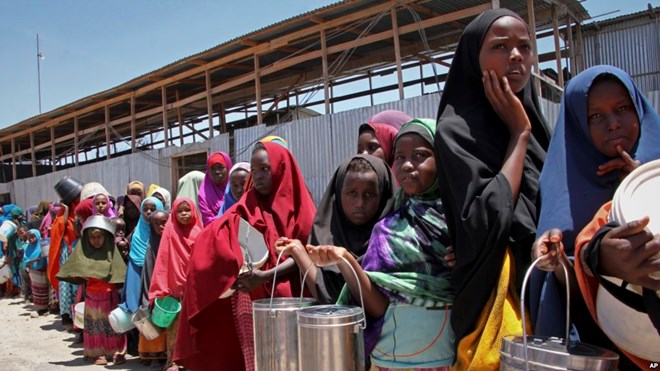
Sunday April 9, 2017

FILE - In this photo taken Feb. 25, 2017, displaced Somali girls who fled the drought in southern Somalia stand in a queue to receive food handouts at a feeding center in a camp in Mogadishu, Somalia.
Over the past several months, working through USAID and its partners, the U.S. government has accelerated assistance to Somalia, providing food and malnutrition treatment, ensuring drinking water is safe, and improving sanitation and hygiene.
advertisements
Some 14.4 million people in Somalia, Ethiopia, and Kenya need humanitarian assistance, according to the United Nations. In some places, acute food insecurity could soon deteriorate into famine.“Famines are rare, and we don’t use the term lightly. In most cases, people face extreme food insecurity and are in need of emergency food assistance without the situation being categorized as a famine,” said Matthew Nims, Acting Director of USAID’s Office of Food for Peace, in testimony before the U.S. House of Representatives. In February, the UN declared famine in South Sudan, while regions of three other countries—Somalia, Nigeria and Yemen—are teetering on the brink.
Next to South Sudan, Somalia is the country of greatest concern. Here, the effects of the latest drought are exacerbated by conflict, said Mr. Nims. “The below-average rainfall of the 2016 October-to-December season has resulted in a harvest forecasted to be 50 to 70 percent below the five-year average.”
The conditions are similar to 2011, when nearly 260,000 Somalis died in a famine triggered by what was, at the time, the Horn of Africa’s worst drought in over 60 years.
But the comparisons stop there. “In February, the governments of Djibouti, Ethiopia, Kenya and Somalia all publicly committed to regional cooperation and cross-border collaboration to tackle both this drought and, through longer-term investments, the underlying fragility that tips vulnerable communities into crisis in recurring droughts,” said Acting Director Nims.
Over the past several months, working through USAID and its partners, the U.S. government has accelerated assistance to Somalia, providing food and malnutrition treatment, ensuring drinking water is safe, and improving sanitation and hygiene. And to ensure lasting impact, assistance in Somalia is sometimes linked to activities such as vocational training, designed to help build the resilience of the Somali people.
“We remain committed to providing humanitarian assistance around the world as both a moral imperative and as a direct benefit to the well-being of the United States,” said Acting Director Nims.
“We do this work not only because it is the right thing to do, but also because it is in the interest of the American people and promotes global stability.”